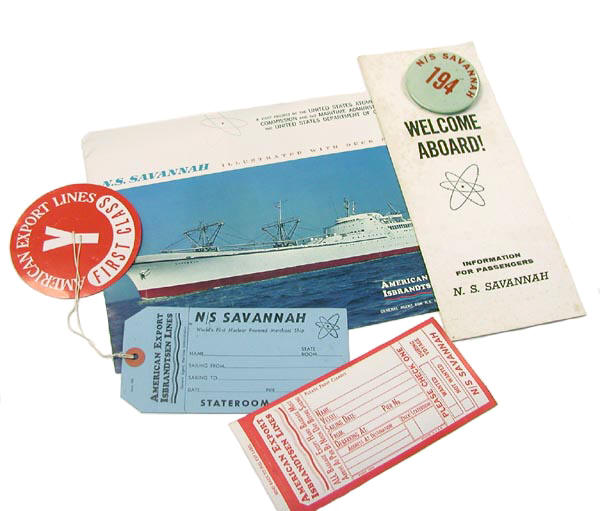Items from the Savannah (1960s)

The above photo shows two informational booklets given to passengers aboard the Savannah, a numbered button used by crew members, a circular red luggage sticker, a light blue luggage tag, a luggage label.
The History of the Savannah
The N.S. Savannah (named after the first steamship to cross the Atlantic) was the world’s first nuclear powered merchant ship. It operated as both a passenger ship and a cargo ship carrying up to 60 passengers and 9,250 tons of cargo. Todd Shipyards in Galveston, Texas served as her home port.*
The Savannah was a joint effort of the Maritime Administration of the Department of Commerce and the Atomic Energy Commission. Congress approved the project in 1956, and the ship was launched July 21, 1959. The maiden voyage, which began in August 1962, took the Savannah from Yorktown VA to Savannah, Georgia.
A ship's "deck officers" were traditionally paid more than its "engineering officers" (the two groups were represented by different unions), but this was not the case on the Savannah. The latter's engineering officers had BS degrees in engineering from the U.S. Merchant Marine Academy at Kings Point, NY., and had spent two years at the Babcock and Wilcox facility in Lynchburg, Virginia receiving training for their reactor and senior reactor operator licenses. The salary issue resulted in everyone walking off the ship and a shutting down of the Savannah's operations. In May of 1963, American Export Isbrandtsen Lines took over from the original contractor, States Marine Lines, and the troublesome crew was replaced.
Unfortunately, the Savannah operated at a loss and the ship never gained the full support of the Maritime Administration. The decision to mothball the Savannah came in 1967. For many years the Savannah was located in Charleston South Carolina where she operated as a floating museum. In July of 1994, the Savannah was towed from Charleston to the James River Reserve Fleet in Norfolk Virginia, and moored alongside the Sturgis, a floating Army Corps of Engineers nuclear power plant.
Ship dimensions: 596 feet long and 78 feet across at the beam
Reactor details: 69 MW. The pressure vessel, the heat exchanger, the pressurizer, etc., were located inside a hemispherical steel containment vessel located just forward of the bridge. The bottom half of the vessel was encased in concrete while the top half was enclosed in steel and redwood timber. Water cooled. Heat from the reactor produced steam which turned the turbine and the propeller shaft.
Fuel: 682,000 enriched uranium oxide pellets, enough for three and one half years of normal operation
Health physics survey instrumentation:
- 8 AN/PDR-27J GM Survey meters
- 3 Jordan Ion Chambers (0-50 R)
- 3 Victoreen Ion Chamber survey meters (0-500 R)
- 1 Victoreen high range ion chamber 0-10,000 rad
- 1 Victoreen Model 70 condenser R meter
- 2 Eberline FN-1 fast neutron survey meters
- 2 Nuclear Chicago Model 2715 neutron survey meters
- 2 Nuclear Chicago Model 2586 Cutie Pie Ion chambers
- 2 Technical Associates Juno ion chamber survey meters
- 2 Eberline PAC-IS alpha survey meters
- 4 Nems Clarke air sampler
- 2 Gelman portable air samplers
- 1 argon-41 gas sampler
Health physics laboratory instrumentation:
- 4 Nuclear Chicago Model CP/297 scalers
- 1 Technical Associates lead shield with GM
- 1 Technical Associates lead shield with low background GM detector.
- 1 Nuclear Chicago lead shield
- 1 alpha, beta and gamma scintillator
- 1 RCL 128 gamma spectrometer
- 1 2” NaI crystal
- 1 Tracerlab SU-3 Laboratory monitor
Radiation exposure rates and dosimetry
The 1962 Health Physics surveys indicated that the highest exposure rates (up to 210 mR/hr) were found in the charge pump rooms.
Passengers were not monitored. Crew members wore Oak Ridge National Laboratory film badges. During the May-December 1962 period, the highest weekly dose was 700 mrem. The average was less than 5 mrem per week with only two individuals exceeding 20 mrem in a week.
Trivia
The Savannah had its own servant—a barge, the “Atomic Servant” functioned as a maintenance, refueling and waste processing facility for the Savannah.
*Galveston at that time was a rough and tumble town where the Texas Rangers struggled to control the illegal gambling and prostitution. Technically the town was "dry," but there were plenty of private clubs (with peep holes in the door) to provide the crew with alcohol. Should they want it, that is.
Various items donated by “an old sailor who sailed on the Savannah.”
References
- John Poston, Personal communication.
- Nucleonics July 1962; 29.
- Nucleonics March 1967: 5.
- Nucleonics April 1967: 9.
- Levine, Memorandum, Update on N.S. Savannah, U.S. Dept. of Transportation, July 15, 1994.
- Levine, Memorandum, Update on N.S. Savannah, U.S. Dept. of Transportation, July 22, 1994.
- S. Savannah Annual Health Physics Report May 1, 1962 – December 31, 1962, TODD/SML-NSS 8.
- S. Savannah Health Physics Manual, TODD/SML-NSS 17.
- S. Savannah, Brochure given to passengers, May 1964.
